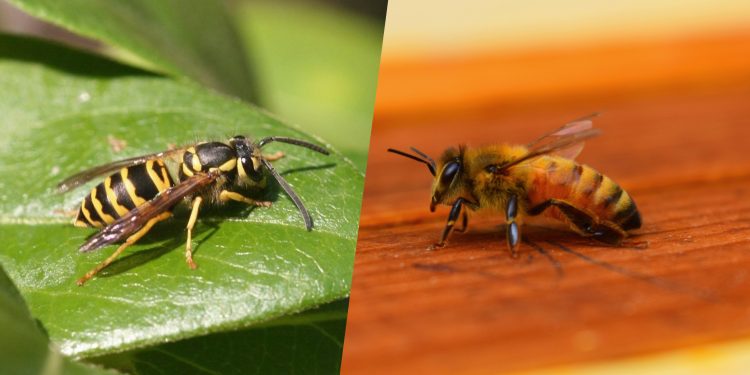Introduction to Bees Vs Wasps
Bees and wasps are some of the most fascinating, but also sadly misunderstood, insects in the animal kingdom. They are important pollinators, predators, and scavengers, and play crucial roles in ecosystems in our backyards and around the world.
Yes, bees and wasps are related. They are both in the order Hymenoptera, which also includes ants. Bees and wasps are both social insects that live in colonies. They both have two pairs of wings and a narrow waist. However, they belong to different families, with bees belonging to Apidae, and wasps to various families like Vespidae, Sphecidae, and Pompilidae.
They evolved from a common ancestor over 100 million years ago and share many physical characteristics, but also have distinct features that reflect their different lifestyles and ecological roles.
Here’s a quick breakdown of some key differences:
Bees
 Bees are fuzzy and have pollen baskets on their hind legs.
Bees are fuzzy and have pollen baskets on their hind legs.
 Bees collect nectar and pollen from flowers to make honey.
Bees collect nectar and pollen from flowers to make honey.
 Bees only sting when they feel threatened.
Bees only sting when they feel threatened.
Wasps
 Wasps are smooth and do not have pollen baskets.
Wasps are smooth and do not have pollen baskets.
 Wasps eat other insects, spiders, and other small animals.
Wasps eat other insects, spiders, and other small animals.
 Wasps can sting multiple times.
Wasps can sting multiple times.
Bees and wasps both play important, yet different roles in the environment. Bees pollinate flowers, which helps plants to reproduce. Wasps help to control populations of other insects, such as mosquitoes and flies.
Here is a table that summarizes the key differences between bees and wasps:
| Bees | Wasps | |
|---|---|---|
| Social Structure | Eusocial (living in a cooperative group), live in large colonies with a queen and workers | Can be solitary or social, live in small groups or large colonies with a queen and workers |
| Diet | Mostly herbivorous, feed on nectar and pollen | Omnivorous, feed on nectar, pollen, other insects, and sometimes meat |
| Body Shape | Rounded, fuzzy body | Slender, smooth body |
| Hair | Covered in branched hairs for pollen collection | Less hairy, with some species having smooth, shiny exoskeletons |
| Defense Mechanisms | Will only sting once and die, usually non-aggressive | Can sting multiple times, often more aggressive |
| Nesting Habits | Nest in hives, often in cavities or underground | Nest in paper nests, in cavities or exposed locations |
| Ecological Role | Pollinate crops and plants, important for food production | Predators, important for pest control and ecosystem balance |
Let’s go into a bit more detail.
Taxonomy of Bees and Wasps
Bees and wasps are both members of the order Hymenoptera, which also includes ants, sawflies, and hornets. Hymenoptera is characterized by two pairs of wings and a narrow waist, or petiole, between the thorax and abdomen.
Within the order Hymenoptera, bees and wasps are classified into different families. Bees are members of the family Apidae, which includes over 20,000 species of bees, including honey bees, bumblebees, and carpenter bees. Wasps, on the other hand, belong to the family Vespidae, which includes more than 5,000 species of wasps, including yellow jackets, hornets, and paper wasps.
Evolution: Bees vs Wasps
Bees and wasps share a common ancestor that lived over 100 million years ago. This ancestor was a wasp-like insect that fed on the nectar and pollen of plants. Over time, some of these insects evolved to become specialized pollinators and gave rise to the first bees.
The evolution of bees and wasps is closely linked to the evolution of flowering plants, which first appeared around 130 million years ago. As flowering plants diversified, so did the bees and wasps that pollinated them.
Physical Differences between Bees and Wasps
Bees and wasps have many physical similarities, but they also have several distinguishing features. Bees are generally rounder and fuzzier than wasps, with flat legs and branched hairs that help them collect pollen. They also have longer tongues than wasps, which allows them to reach deep into flowers to collect nectar.
Wasps, on the other hand, are generally longer and thinner than bees, with smooth legs and a more streamlined body. They have longer antennae than bees, which are often curled at the tip, and their wings are held flat against their body when at rest.
Behavior and Habits of Bees vs Wasps
Bees and wasps also have different behaviors and habits. Bees are generally social insects that live in colonies and work together to gather food and care for their young. They are important pollinators and play a crucial role in the ecosystem.
Wasps, on the other hand, can be either solitary or social, depending on the species. Solitary wasps hunt and kill other insects for food, while social wasps live in large colonies and build nests out of paper pulp. Some species of wasps are also important pollinators, but they are primarily known for their role as predators.
Roles of Bees and Wasps in Nature
Both bees and wasps play important ecological roles in the ecosystem. Bees are crucial pollinators of many plants, including many crops that humans rely on for food. Without bees, many of these plants would not be able to reproduce and would eventually die out. Bees are also an important food source for many animals, including birds, mammals, andother insects.
Wasps are also important predators and help to control the populations of other insects, including many pest species. They are also important scavengers and help to clean up decaying plant and animal matter. Some species of wasps are also important pollinators, but their role as predators and scavengers is often more prominent.
Common Misconceptions about Bees and Wasps
There are many misconceptions about bees and wasps that persist in popular culture. One of the most common misconceptions is that all bees and wasps are aggressive and likely to sting. While it is true that some species of bees and wasps are more likely to sting than others, many species are relatively docile and will not sting unless provoked.
Another common misconception is that all bees make honey. In fact, honey is produced only by a few species of bees, including the honey bee of course. Other species of bees, such as bumblebees, do not make honey, but still play an important role as a pollinator.
Some people also believe that wasps serve no useful purpose and are simply pests. However, wasps play an important ecological role as predators and scavengers and can be beneficial in controlling other insect populations (like spiders!)
Bees vs wasps, the summary
So, as we’ve covered above, you can see that bees and wasps have quite a bit in common, but also have some key differences. The most important thing to remember is that both bees and wasps play important ecological roles in the ecosystem, and are fascinating and important insects that deserve our respect and admiration, and not a rolled up newspaper!
FAQs
Are bees and wasps in the same family?
Bees and wasps are both members of the order Hymenoptera, but they belong to different families. Bees belong to the family Apidae, while wasps belong to a variety of families, including Vespidae, Sphecidae, and Pompilidae.
Did wasps evolve from bees?
No, wasps did not evolve from bees. Both bees and wasps evolved from a common ancestor that lived over 100 million years ago. While they share many physical characteristics, they also have distinct features that reflect their different lifestyles and ecological roles.
What is the relationship between a bee and a wasp?
Bees and wasps are both members of the order Hymenoptera and share a common ancestor, but they have different ecological roles and behaviors. Bees are primarily known for their role as pollinators, while wasps are important predators and scavengers.
Is a bee a wasp?
No, a bee is not a wasp. Bees and wasps are different types of insects, although they share many physical similarities. Bees are generally hairy and have a more robust, stocky body shape, while wasps are often hairless and have a more slender, elongated body shape.
Are bees friendlier than wasps?
It is not accurate to say that bees are friendlier than wasps. Both bees and wasps can sting if they feel threatened or provoked. However, some species of bees and wasps are more aggressive than others, and it is important to be aware of the risks associated with interacting with these insects.


![3 Big Mistakes Beginner Beekeepers Make [And How To Avoid Them!]](https://beekeepingabc.com/wp-content/uploads/2020/11/3-mistakes-beginner-beekeepers-make-90x75.jpg)

![Move over ducks, Queen Bees quack too! [Here’s Why]](https://beekeepingabc.com/wp-content/uploads/2020/06/queen-bee-90x75.png)
![The Flow Hive 2 Review [ Vs. The Classic Flow Hive]](https://beekeepingabc.com/wp-content/uploads/2020/02/Flow-Hive-2-90x75.jpg)
![How Bees Fly [10 Facts About How, When, and Why]](https://beekeepingabc.com/wp-content/uploads/2019/12/A-Bee-Flying-90x75.jpg)